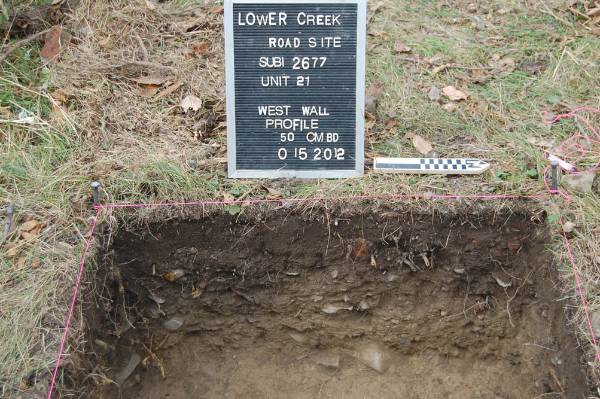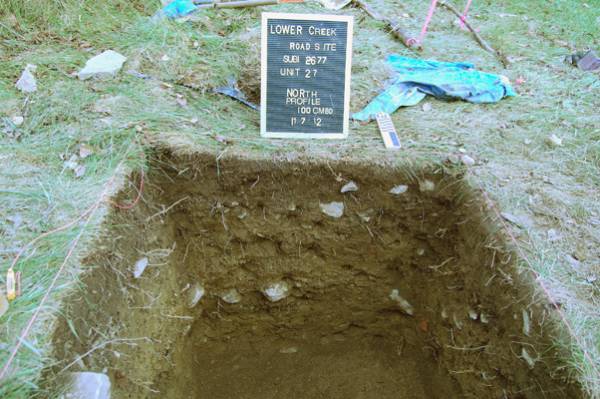Phase I: Archaeological Survey
PAF crews initially identified the Lower Creek Road Site during a reconnaissance survey in 2007. The site consisted of a moderate density sheet midden (refuse scatter) around a stone foundation. The foundation had been a residence built prior to 1853 and demolished between 1898 and 1900 based on historic maps. Archaeologists recovered 92 historic artifacts from a grid of shovel test pits (STPs) placed at an interval of 7.5 m (25 ft). The site measured approximately 30 m (98.4 ft) long and 25 m (82 ft) wide for a total site area of 750 m² (8,073 ft²). Based on the results of the survey, PAF archaeologists recommended a site examination as well as archival research to determine the site’s eligibility to the National Register of Historic Places.
Phase 2: Site Examination and Addendum Survey
Following the initial survey, PAF crews conducted a site examination to collect sufficient information to determine if the site was eligible for the National Register of Historic Places. The site examination consisted of the excavation of 10 test units measuring 1 x 1 m (3.3 x 3.3 ft). The units were placed in areas where reconnaissance STPs suggested potential for high frequencies and diversity of artifacts, and in areas that could provide information on the functional use of the yard spaces within the site.
The soils at the Lower Creek Road Site included an A horizon overlaying a sterile B horizon. The A horizon consisted of a dark brown silt loam and contained the majority of the recovered artifacts. The B horizon consisted of a yellowish brown silt loam with rocks. Diagnostic artifacts recovered from the site were generally from the mid to late 19th century and associated with the Casper Miller household. Besides the stone foundation, a stone lined well and remains of a cut stone entry steps were documented on the surface of the site.
The site examination produced 1,445 artifacts. These artifacts included architectural, food-related, household, clothing, personal, lighting, smoking related materials, and faunal and food remains. Minor amounts of household, clothing, personal/cosmetic, lighting, and smoking items were recovered. The site contained a diverse amount of data with high research potential that could be informative about early households within Central New York. A data recovery was proposed for those areas with the potential to increase the relative diversity and density of the assemblage, and contribute to research questions related to the early history of the Hudson Valley.
In 2011, an additional survey was conducted to test areas added to the project area and to better determine the site’s limits. The addendum survey recovered an additional 18 artifacts from three STPs and increased the size of the site to an approximate length of 40 m (131 ft) and width of 40 m (131 ft) for a total area of 960 m² (10,333 ft²). The recovered material was consistent with the material recovered during the initial survey and site examination. The soils also showed a stratigraphic pattern similar to that identified during the initial survey and site examination.
The Phase 2 site examination determined that the site was eligible for inclusion on the National Register of Historic Places under Criterion D – its potential to yield important information on the history and archaeology of the region. Impacts to the site could not be avoided, and therefore mitigation consisted of a final excavation (Phase 3) to recover a representative sample of artifacts from the site.
Phase 3: Data Recovery
A data recovery project was conducted in the fall of 2012. A representative sample of the site was excavated. The spatial information collected provided a context for interpreting the site’s material cultural, which in turn allowed archaeologists to better interpret the daily lives of the people who lived at the site during the 19th century. The data recovery excavations consisted of 20 test units measuring 1 x1 (3.3 x 3.3 ft). In total, PAF archaeologists excavated approximately 4% of the site.

